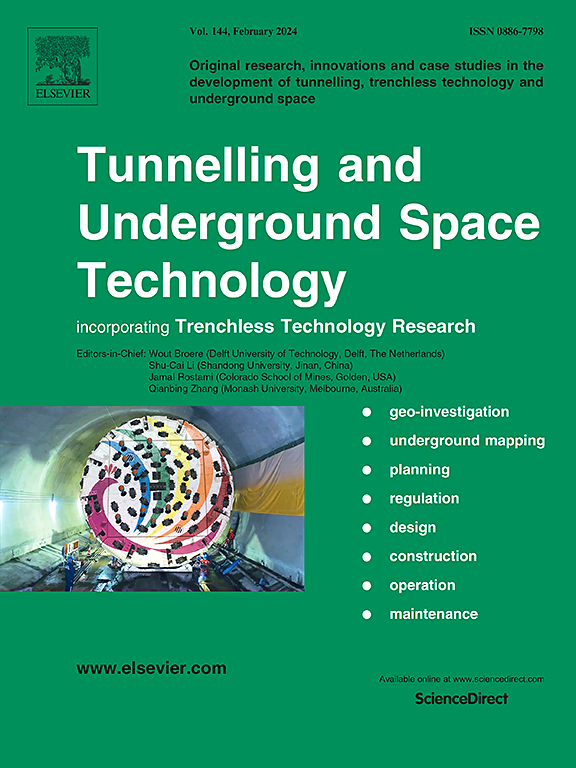Laboratory testing of large diameter open caisson sinking friction in sand
IF 6.7
1区 工程技术
Q1 CONSTRUCTION & BUILDING TECHNOLOGY
引用次数: 0
Abstract
The construction procedure for open-dug in-situ caisson shafts involves concurrent casting of reinforced concrete walls and excavation of soil from within the structure. This process causes the shaft to ‘sink’ into the ground, driven by the self-weight of the walls. A key design concern during construction is the build-up of frictional stresses (skin friction) on the exterior surface of the caisson walls by the surrounding soil. A lubricant filled annulus is typically used to minimise skin friction, however recent field monitoring results suggest this may not always be effective in sands. Ensuring minimisation of skin friction in sands is therefore a critical design priority. This paper presents results from novel experimental testing that simulates the sinking process at a reduced scale. Four tests were conducted focusing on two key factors that influence skin friction: annulus formation and lubrication. Interface stress sensors were used to measure the skin friction and normal stresses at the interface, whilst particle image velocimetry was used to track soil displacements. The results show that lubrication, either with or without an annulus, effectively reduces skin friction. However, lubricating without an annulus only leads to localised friction reduction, suggesting close spacing of lubricant ports can be used to ensure effective friction reduction even without effective annulus formation. The results also show annulus formation without effective lubrication can lead to an increase in skin friction, the opposite of friction fatigue for displacement piles, representing the first experimental measurements to validate caisson field monitoring results in the literature.
大直径开式沉箱在砂土中下沉摩擦的室内试验
现挖沉井井的施工程序包括钢筋混凝土墙的同时浇筑和结构内部的挖土。这个过程导致竖井在墙体自重的驱动下“下沉”到地下。在施工过程中,一个关键的设计问题是由周围的土壤在沉箱墙的外表面上形成的摩擦应力(表皮摩擦)。通常使用填充润滑油的环空来减少表面摩擦,但最近的现场监测结果表明,这可能并不总是有效的砂。因此,确保砂层表面摩擦最小化是设计的关键优先事项。本文介绍了一种新颖的实验测试结果,该测试模拟了缩小规模的下沉过程。针对影响皮肤摩擦的两个关键因素:环空形成和润滑,进行了四项试验。界面应力传感器用于测量界面处的表面摩擦和法向应力,而颗粒图像测速仪用于跟踪土壤位移。结果表明,润滑,无论是有或没有环,有效地减少皮肤摩擦。然而,没有环空的润滑只能导致局部的摩擦减少,这表明即使没有有效的环空形成,也可以使用紧密的润滑端口间距来确保有效的摩擦减少。研究结果还表明,在没有有效润滑的情况下,环空的形成会导致表面摩擦增加,与位移桩的摩擦疲劳相反,这是文献中第一次验证沉箱现场监测结果的实验测量。
本文章由计算机程序翻译,如有差异,请以英文原文为准。
求助全文
约1分钟内获得全文
求助全文
来源期刊

Tunnelling and Underground Space Technology
工程技术-工程:土木
CiteScore
11.90
自引率
18.80%
发文量
454
审稿时长
10.8 months
期刊介绍:
Tunnelling and Underground Space Technology is an international journal which publishes authoritative articles encompassing the development of innovative uses of underground space and the results of high quality research into improved, more cost-effective techniques for the planning, geo-investigation, design, construction, operation and maintenance of underground and earth-sheltered structures. The journal provides an effective vehicle for the improved worldwide exchange of information on developments in underground technology - and the experience gained from its use - and is strongly committed to publishing papers on the interdisciplinary aspects of creating, planning, and regulating underground space.
 求助内容:
求助内容: 应助结果提醒方式:
应助结果提醒方式:


